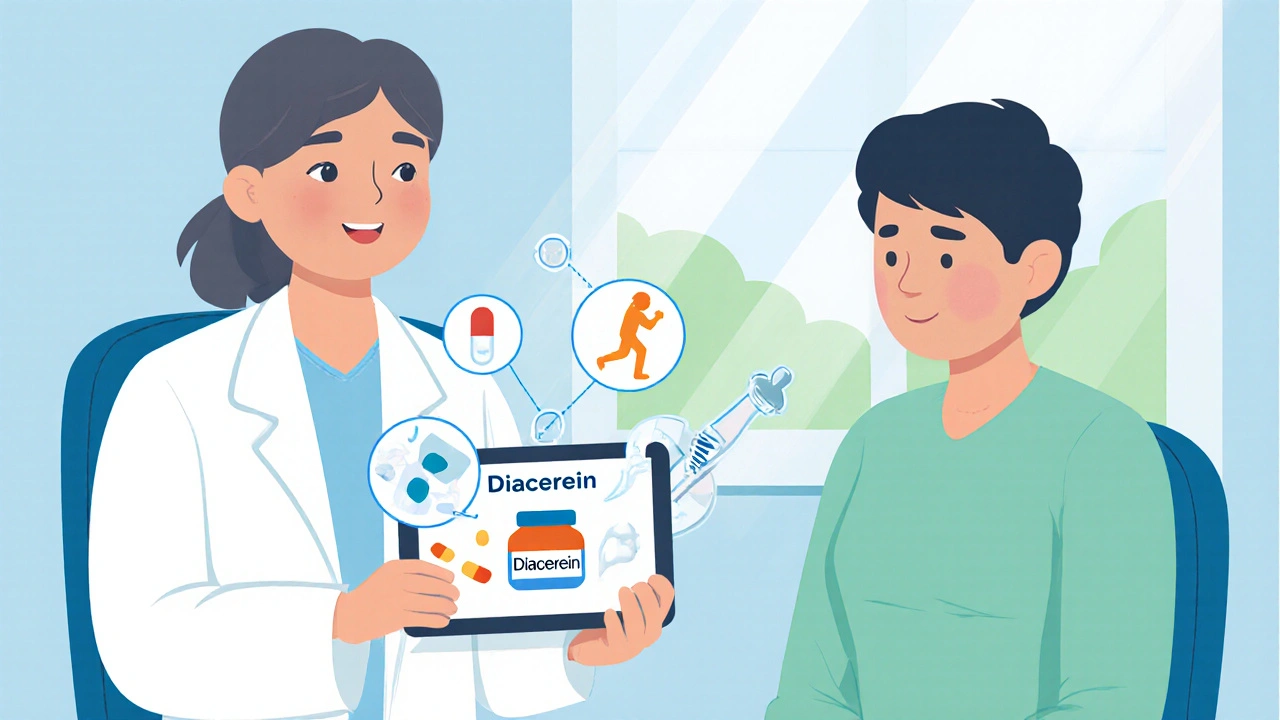When you’re looking for a thorough Diacerein comparison, the choices can get confusing. Diacerein has been on the market for decades, yet many patients and clinicians still wonder whether it really stands up against the more familiar NSAIDs, supplements, or injection therapies. This guide breaks down the science, the safety profile, the cost, and the practical considerations so you can decide if Diacerein belongs in your osteoarthritis toolkit.
Key Takeaways
- Diacerein is a disease‑modifying agent that targets inflammation and cartilage breakdown, unlike most NSAIDs that only mask pain.
- Its onset of relief is slower (2‑4 weeks) but may provide longer‑lasting symptom control.
- Gastro‑intestinal side effects (especially diarrhea) are the most common adverse events; liver monitoring is advisable.
- Cost per month is higher than generic NSAIDs but comparable to prescription‑only supplements and hyaluronic‑acid injections.
- Choosing the right therapy depends on patient age, comorbidities, tolerance, and how quickly relief is needed.
Below you’ll find a step‑by‑step walk‑through of the most relevant alternatives, a side‑by‑side table, and a short FAQ that covers the questions most people ask after reading the comparison.
Understanding Diacerein
Diacerein is a symptomatic slow‑acting drug for osteoarthritis (SYSADOA) that works by inhibiting interleukin‑1 and reducing cartilage‑degrading enzymes. It is taken orally, typically 50 mg twice daily after meals. Because it modulates the inflammatory cascade rather than just blocking cyclo‑oxygenase (COX), it can theoretically slow cartilage loss.
Key attributes:
- Mechanism: IL‑1β inhibition, MMP (matrix‑metalloproteinase) suppression.
- Typical dose: 50 mg twice daily.
- Onset of relief: 2‑4 weeks.
- Main side effects: Diarrhea (30‑40 % of users), mild liver enzyme elevation.
- Regulatory status: Prescription‑only in Australia, OTC in some European countries.
Popular Alternatives
Most clinicians start with non‑steroidal anti‑inflammatory drugs (NSAIDs) or over‑the‑counter supplements before considering disease‑modifying agents. Here are the five most common alternatives:
Celecoxib is a COX‑2‑selective NSAID that reduces inflammation and pain while sparing most of the stomach lining. It’s often prescribed when patients can’t tolerate traditional NSAIDs.
Diclofenac is a non‑selective NSAID widely used for short‑term pain relief in osteoarthritis. It’s available in oral, topical, and injectable forms.
Glucosamine is a naturally occurring amino‑sugar that serves as a building block for cartilage proteoglycans. Sold as a dietary supplement, it’s popular among patients seeking a “natural” option.
Hyaluronic Acid is a viscous gel injected into the knee joint to improve lubrication and shock absorption. It’s classified as a medical device in many jurisdictions.
Physical Therapy is a non‑pharmacologic approach that combines exercises, manual therapy, and patient education to improve joint function. It’s often recommended as a first‑line strategy.
Side‑by‑Side Comparison Table
| Drug / Therapy | Mechanism | Typical Dose / Regimen | Onset of Relief | Main Side Effects | Average Monthly Cost (AU$) |
|---|---|---|---|---|---|
| Diacerein | IL‑1β inhibition, MMP suppression | 50 mg × 2 daily after meals | 2‑4 weeks | Diarrhea, mild liver enzyme rise | ~$80‑$120 |
| Celecoxib | COX‑2 selective inhibition | 200 mg once daily (or 100 mg × 2) | Within days | Cardiovascular risk, GI upset | ~$30‑$45 (generic) |
| Diclofenac | Non‑selective COX inhibition | 50 mg × 3 daily (oral) or topical gel | Within days | GI bleeding, renal effects | ~$25‑$35 (generic) |
| Glucosamine | Provides substrate for cartilage synthesis | 1500 mg once daily | 4‑12 weeks (if effective) | Stomach upset, rare allergy | ~$20‑$30 (OTC) |
| Hyaluronic Acid Injection | Viscosupplementation of joint fluid | 1 ml × 3‑5 weekly injections | 2‑4 weeks (after series) | Injection site pain, rare infection | ~$300‑$500 (course) |
Efficacy: How Quickly Will You Feel Better?
NSAIDs such as Celecoxib and Diclofenac act on the COX pathway, delivering pain relief within hours to a couple of days. That makes them ideal for flare‑ups or when a patient needs immediate function.
Diacerein, on the other hand, requires a few weeks to reach therapeutic levels in the joint tissue. Clinical trials (e.g., the European Osteoarthritis Study Group, 2022) showed a modest but statistically significant reduction in WOMAC pain scores after 12 weeks compared with placebo.
Glucosamine’s evidence is mixed. Meta‑analyses published in 2021 and 2023 found a small benefit in pain reduction for people with mild‑to‑moderate knee OA, but the effect size is comparable to placebo for severe disease.
Hyaluronic‑acid injections can provide noticeable improvement after the full series, usually 3‑5 weeks, but results vary widely between patients. Some experience a rapid drop in pain, while others see little change.
Physical therapy doesn’t deliver a quick “pill‑effect” but improves joint mechanics over weeks to months. When combined with any pharmacologic therapy, it consistently enhances outcomes.
Safety Profile: Which Risks Matter Most?
Gastro‑intestinal complications are the headline concern for non‑selective NSAIDs (Diclofenac). In older adults, the risk of ulcer bleeding can be as high as 5‑6 % per year. COX‑2‑selective agents like Celecoxib lower GI risk but raise cardiovascular concerns-especially in patients with hypertension or a history of heart disease.
Diacerein’s most frequent adverse event is watery diarrhea, affecting up to 40 % of users in the first month. The effect often decreases after dose titration, but for patients with dehydration risk, it can be limiting. Liver function tests should be checked at baseline and after 4-6 weeks.
Glucosamine is generally safe, with mild stomach upset being the most common complaint. Rare cases of shellfish allergy have been reported because many formulations are derived from crustacean shells.
Injection‑related risks for hyaluronic acid include local pain, swelling, and very rare infection (<0.1 %).
Physical therapy carries minimal systemic risk. The primary concern is temporary soreness after an intense session, which can be mitigated with proper progression.
Cost Considerations in Australia
Healthcare budgeting matters, especially when out‑of‑pocket expenses are involved. Medicare covers a portion of prescription NSAIDs when a doctor writes a PBS (Pharmaceutical Benefits Scheme) authority, bringing the cost down to <$10 per month for generic Diclofenac.
Diacerein is not listed on the PBS, so patients pay the full price-about $80‑$120 per month for a 30‑day supply from most pharmacies.
Glucosamine, being an over‑the‑counter supplement, costs $20‑$30 per month and is not subsidized.
Hyaluronic‑acid injections are reimbursed only in limited cases (e.g., severe OA unresponsive to other therapy). Most patients shoulder $300‑$500 for a full treatment course.
Physical therapy sessions typically run $60‑$90 per visit, with insurance or private health cover sometimes covering a portion of the fee after a referral.
Putting It All Together: Choosing the Right Option
Here’s a quick decision tree to help you match a therapy to a patient profile:
- Need rapid pain relief? Start with an NSAID (Celecoxib if GI risk, Diclofenac if cost is a primary concern).
- Concerned about long‑term cartilage health? Consider Diacerein or a structured glucosamine regimen, especially if the patient can tolerate mild GI upset.
- Has a history of cardiovascular disease? Avoid COX‑2 inhibitors; prefer Diacerein or topical NSAIDs.
- Prefers non‑drug approaches? Physical therapy alone or combined with nutraceuticals can be effective for mild‑to‑moderate OA.
- Severe knee pain unresponsive to oral meds? Hyaluronic‑acid injections may offer additional relief, but discuss cost and limited insurance coverage.
In practice, many clinicians use a hybrid approach: an NSAID for flare‑ups, Diacerein for disease‑modifying intent, and a regular physiotherapy program for functional improvement.
Practical Tips for Prescribing Diacerein
- Start with 50 mg once daily for the first week to gauge tolerability, then increase to twice daily.
- Advise patients to take the dose with food to lessen GI irritation.
- Schedule liver function tests at baseline and after 4 weeks; repeat if abnormal.
- Encourage adequate hydration, especially during the first month when diarrhea is common.
- Combine with low‑impact exercise (e.g., swimming, cycling) to maximize joint health.
Frequently Asked Questions
Is Diacerein available over the counter in Australia?
No. Diacerein is a prescription‑only medicine here. A doctor must write a script, and the pharmacy will dispense it after checking your health history.
Can I take Diacerein together with an NSAID?
Yes, many clinicians co‑prescribe a short course of an NSAID for immediate pain relief while Diacerein builds its effect. However, watch for cumulative GI side effects and discuss any liver concerns with your doctor.
How long should I stay on Diacerein?
Most studies evaluate a 12‑month treatment period. If you experience noticeable improvement and tolerate the drug well, continuation beyond a year can be considered, but regular liver monitoring remains essential.
Is Diacerein safe for people with kidney disease?
Diacerein is primarily metabolized by the liver, so it is generally safer for kidneys than NSAIDs. Still, your nephrologist should review kidney function before starting.
What should I do if I get severe diarrhea on Diacerein?
Immediately contact your prescriber. They may reduce the dose, switch to once‑daily dosing, or stop the medication. Staying hydrated is crucial while awaiting medical advice.
Bottom line: Diacerein offers a unique disease‑modifying angle that fills a gap left by fast‑acting NSAIDs. Its slower onset and GI profile mean it isn’t a universal replacement, but for patients who need longer‑term cartilage protection and can handle mild diarrhea, it’s worth a serious look alongside the more common alternatives.



 Medications
Medications





Kevin Stratton
October 25, 2025 AT 17:08When you weigh the instant comfort of NSAIDs against the slower, cartilage‑sparing promise of Diacerein, you’re really juggling short‑term relief with long‑term stewardship of the joint 🙂. The philosophy reminds me of the classic dilemma: pleasure now versus virtue later. Diacerein’s IL‑1β blockade may not knock the pain out in a day, but it nudges the disease trajectory in a subtler direction. That trade‑off feels worth contemplating for anyone who envisions staying active for decades. In the end, it’s a personal calculus of risk, cost, and patience.
Manish Verma
November 6, 2025 AT 19:15As an Aussie who’s seen our health system fight for affordable meds, I can’t help but call out the hype around pricey alternatives. Diacerein, despite its prescription‑only label Down Under, actually gives a more balanced profile than a cocktail of NSAIDs that chew up the stomach. Sure, the diarrhea is a nuisance, but it’s far less lethal than a GI bleed that can land you in ICU. From a national‑pride standpoint, supporting a drug that modifies disease rather than just masking pain is the right move. Bottom line: give Diacerein a fair shake before writing it off.
Leanne Henderson
November 18, 2025 AT 22:21Honestly, the cost‑to‑benefit picture looks a lot friendlier when you stack the numbers side by side, especially if you factor in the hidden expenses of chronic NSAID‑induced ulcers, heart risks, and the occasional surprise ER visit, which can quickly eclipse the monthly price tag of Diacerein, and let’s not forget the emotional toll of dealing with persistent pain, which once you add that up, makes the slower onset feel like an investment in peace of mind, really.
Megan Dicochea
December 1, 2025 AT 01:28Diacerein’s safety profile isn’t perfect but it’s manageable with proper monitoring. Start low, watch stools, check liver enzymes and you’ll be fine.
Donal Hinely
December 13, 2025 AT 04:35Think of Diacerein as the quiet ninja in the pharmacy aisle-while NSAIDs storm the joint with fireworks, this little tablet slips in late, disarms the inflammatory villains and leaves the cartilage unharmed, all the while giving your gut a break from the usual fireworks display.
Diane Holding
December 25, 2025 AT 07:41Consider Diacerein if you prioritize long‑term joint health over quick pain relief.